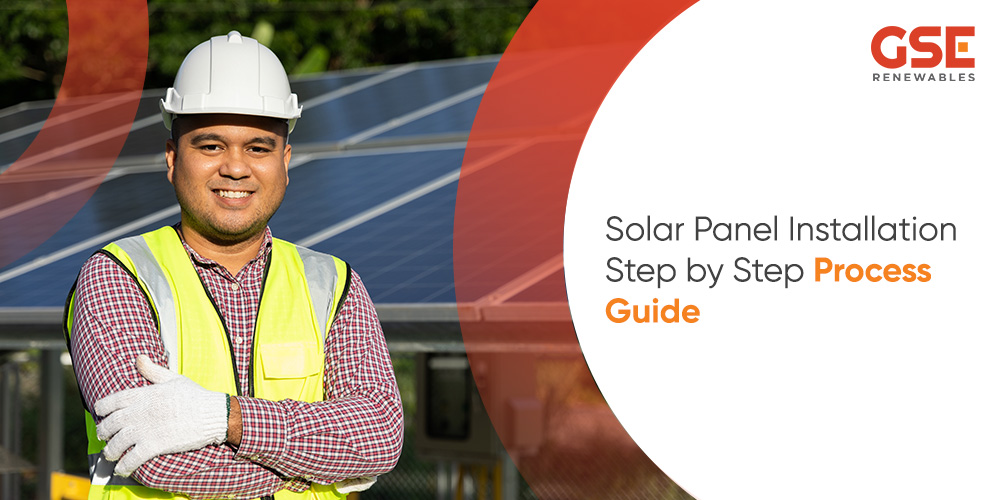Do Solar Panels Work on Rainy Days?
Jul 4

One of the most prevalent sites for installation of photovoltaic panels is on the roof. Roofs commonly possess the necessary specifications for optimal installation, ensuring that the panels receive maximum sunlight exposure.
However, in cases where roof installation is impossible or undesired, an alternative is to mount the solar panels on the ground.
The following are the steps in the solar panel installation procedure:
Begin with the Assembly
To initiate the process, assemble the necessary support structures to ensure safety throughout the installation, particularly when working on the rooftop.
Set Up Solar Panel Mounts
Next, establish the framework for the solar panels. This system provides the essential base for the solar panels and should be angled between 18 to 36 degrees for optimal exposure to sunlight.
Install the Solar Panels
Once the framework is in place, proceed to attach the solar panels securely. Ensure that all bolts and nuts are tightened adequately to maintain stability.
Establish Electrical Connections
The subsequent phase involves connecting the electrical wiring. Typically, MC4 connectors are employed for their compatibility with various solar panel types. It is crucial to turn off the household’s electricity supply during this wiring process.
Install the Solar Inverter
Following the wiring, connect the solar inverter to the system. Usually situated close to the main panel, the inverter can be installed either indoors or outdoors. For improved efficiency, consider placing outdoor inverters away from the afternoon sun, while indoor installations are often best in cool, well-ventilated spaces like garages or utility rooms.
Link the Solar Inverter with the Solar Battery
Subsequently, establish the connection between the solar inverter and the solar battery. The solar battery storage proves valuable during overcast periods, addressing concerns about insufficient usable energy. Moreover, this connection can contribute to lowering solar panel battery costs during the installation phase.
Integrate with the Consumer Unit
Connect the inverter to the consumer unit to commence electricity generation. Additionally, install a generation meter to monitor the actual electricity production by the solar panels. Utilize your computer or other devices to assess the solar system’s performance, enabling informed decisions on the optimal timing for household activities like running appliances.
Power Up and Test the Solar Panels
Conclude the process by activating the power and conducting thorough testing of the newly installed solar panel system. With this, the solar panel installation is successfully completed.
Examine your electric bill
Begin the solar panel installation journey by thoroughly reviewing your electric bill. By carefully reading the bill, you may learn about your monthly energy use in kilowatt-hours (kWh). This information is used to determine the proper size of your solar energy installation. To accurately gauge this, it is recommended to assess the average monthly energy usage over the past 12 months.
Selection of panel model and installation service provider
The choice of the company responsible for supplying and installing your solar energy equipment significantly influences the final outcome. With various solar panel models and costs available, tailored to consumer objectives, planned investments, and manufacturers, it is crucial to commence by estimating costs and potential savings. Opt for a reputable brand that offers optimal solutions for your project, enabling customization for diverse environments.
Technical and feasibility assessment
Before embarking on the installation of the photovoltaic system, a comprehensive study is imperative. This study evaluates the building’s structure, the ideal equipment based on consumption profiles, the number of individuals utilizing the generated energy, and the characteristics of solar radiation in the installation region. Technical experts utilize these study results to recommend suitable equipment aligned with the owner’s goals and budget.
Budget calculation
Using the monthly energy consumption data from your electric bill, you can estimate the cost of implementing solar energy in your home or business. The calculation involves considering factors such as warranty, maintenance costs, and the quantity of panels required for installation.
Integration with the electricity grid
After determining the necessary panels, their weight, and the installation area, it is essential to assess the conditions for integrating the photovoltaic solar system with the existing electrical network on the property. This involves conducting the current generated by sunlight capture to the photovoltaic inverter, converting it to the consumption pattern, and following either the on-grid or off-grid system.
Design, permits, and grants
Once the prior steps are completed, the installer proposes an installation plan, production objectives, and proceeds to install solar panels on your roof upon your acceptance. Subsequently, permits must be obtained to legalize the self-consumption installation, and potential subsidies for solar panel installation in your community should be explored.
Approval from the energy concessionaire
For the system to be fully implemented, the energy concessionaire in the region must authorize the installation on the property and its connection to the electricity grid. Specialized engineers and technicians leverage the technical study and building characteristics to seek approval from the electrical distribution company.
Site examination
A crucial step in the solar panel installation process involves inspecting and selecting an appropriate site. The chosen location should have proper orientation with the sun, be at a suitable height, or have level terrain.
Panel and converter installation
Following approval from the concessionaire, the selected company can proceed with the installation of solar panels based on the specified project and the evaluation of solar incidence on the property. Brackets for panel fixation are secured, and cables connecting the converter and distribution board are connected, emphasizing the use of modern, quality materials with proper certification.
Concessionaire inspection
The final step before harnessing photovoltaic solar energy involves an inspection by the concessionaire. Technicians from the electric company visit the installation site to ensure correct implementation, authorizing the system’s use. The meter may be exchanged or a bidirectional model installed during this process, measuring energy injection into the network and daily consumption in the property, facilitating energy credit availability with the utility.
Read more: Solar Panel Installation Cost in India
Upon completing these 10 steps, the process of solar panel installation becomes more straightforward. Solar electricity is now suitable not only for commercial buildings but also for residential ones. While the cost of installing a solar power unit has decreased, you can still opt for the do-it-yourself (DIY) route to minimize expenses. This Solar Panel Installation Guide provides a detailed, step-by-step approach to installing a solar panel.
Solar energy systems consist of key components of solar panels (pv modules), a mounting system, and a solar inverter equipped with an advanced controller. The solar panels harness sunlight to generate DC electricity, which is subsequently converted into AC electricity by the inverter for household use. The performance of the solar system is monitored and optimized by a sophisticated computerized controller. A solar battery is a must-have for anybody contemplating a battery backup system or an off-the-grid solar setup.
When it comes to installing solar systems, many individuals tend to make mistakes. Let’s delve into these errors and explore ways to sidestep them:
You will avoid mistakes if you follow the processes outlined above, and you will be able to establish the needed wattage, solar battery size, and wire size. Understand that adequate wire size minimizes wire overheating and ensures that your batteries receive optimal power supply.
Maintaining solar panels is a breeze due to their lack of moving parts, resulting in minimal upkeep requirements. Once the initial installation costs are covered, the ongoing maintenance expenses are quite low.
Nevertheless, it’s wise to conduct periodic inspections, roughly a few times a year, to check for any accumulation of dirt or debris on the panels. Ensuring the panels remain clean and unobstructed is crucial for optimal sunlight absorption.
Before taking matters into your own hands and cleaning the panels, it’s advisable to consult with your installation professional regarding warranty conditions. Some solar panel manufacturers may void the warranty if any self-cleaning efforts are undertaken.
For routine cleaning, a regular garden hose can do the trick. It’s best to perform this task in the morning or evening to avoid potential damage caused by spraying cold water on hot panels.
In cases where a more thorough cleaning is required, beyond what a hose can achieve, a sponge with soapy water can be used for scrubbing. Alternatively, considering professional cleaning services is a prudent choice, especially if the panels are situated at a height or need a comprehensive cleaning.
Scheduled examinations by an installer every 4-6 years are recommended to ensure the system’s longevity. Additionally, consulting with your installer about specific maintenance guidelines for your solar system is a proactive step.
If you’re ready to embrace solar energy for your home, your search ends here. Simply fill out the contact form to compare quotes from up to three suppliers in your vicinity. GSE Renewables offers this service free of charge and with no further obligations. Take the leap towards a sustainable future with solar panels!
The cost of solar panels in Mumbai can vary depending on the size of the system, the brand of panels, and the installer. However, as a general rule of thumb, you can expect to pay between ₹70,000 and ₹1,00,000 for a 1 kW solar system.
The following are the step by step guide to install solar panel:
Solar panels are typically installed on the roof of a home or business. The process involves mounting the panels to the roof, connecting them to an inverter, and then connecting the inverter to the electrical grid. The installation process can take a few days to complete.
Solar panels are a very durable investment. They typically have a lifespan of 25 to 30 years.
Solar panels do work in winter, but they will not generate as much electricity as they do in the summer. This is because the days are shorter and the sun is not as strong in the winter. However, even in the winter, solar panels can still generate enough electricity to offset a significant portion of your electricity bill.
Yes, you can install solar panels in your home. However, it is important to make sure that your roof is suitable for solar panels and that you have enough space for the system. You should also get quotes from several different installers before making a decision.
Congratulations! You’ve now completed our step-by-step guide to solar panel installation. By embracing solar energy, you’ve taken a significant step toward a greener and more sustainable future. Remember to consult with a reputable solar panel installer and assess your property’s solar potential before making any decisions. Embrace clean energy and contribute to a brighter tomorrow.

Our Blogs With a combined experience of over 250 years and the successful management of 30 MW of solar energy projects, GSER offers the most efficient solutions. Do Solar Panels Work on Rainy Days? Solar energy is becoming an essential part of the modern energy...
Read MoreThe worldwide move to sustainable energy it is not just a trend its now adopting speed and RE100 (Renewable Energy 100%) ) is right at the heart of this corporate climate action.
Read MoreThe worldwide move to sustainable energy it is not just a trend its now adopting speed and RE100 (Renewable Energy 100%) ) is right at the heart of this corporate climate action.
Read More